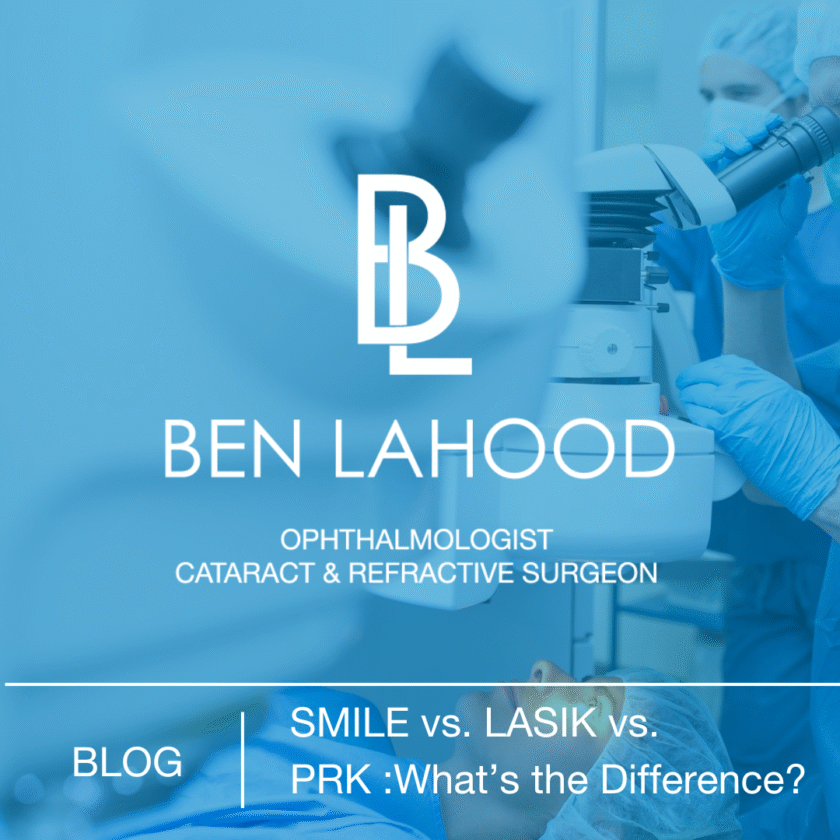
SMILE vs. LASIK vs. PRK – What’s the Difference?
If you’re considering laser vision correction surgery, chances are you’ve come across terms like SMILE, LASIK, and PRK. Each of these laser vision correction procedures is designed to reduce or remove the need for glasses or contact lenses.
Dr Ben LaHood is an ophthalmologist with particular expertise in laser vision correction and is skilled in the use of these three technologies, allowing him to individually tailor laser vision correction solutions for each of his patients to achieve the best results according to their eye health, lifestyle, and visual goals.
In this blog, we explain the differences between SMILE, LASIK, and PRK.
Overview of Your Vision Correction Options
SMILE, LASIK, and PRK are types of laser eye surgery that work to change the shape of the cornea to improve how light focuses on the retina, but use a different process to achieve this same outcome.
What is LASIK?
LASIK (Laser-Assisted In Situ Keratomileusis) is the world’s most commonly performed and proven laser vision correction procedure and involves creating a thin flap in the cornea, lifting it, and then reshaping the underlying tissue using a laser. The flap is then placed back into position to heal. The procedure is quick, with minimal discomfort, has a short recovery time and is appropriate for a broad range of prescriptions.
What is PRK?
PRK (Photorefractive Keratectomy) was the first form of laser vision correction and is still an important option today, particularly for patients who may not be suited to other procedures. Instead of creating a flap, the surface layer of the cornea is gently removed, and the underlying tissue is reshaped. PRK Eye Surgery PRK requires the treatment of less corneal tissue than other procedures, so it is ideal for eyes with thin corneas and is the only laser technique suitable for reshaping irregular corneas.
What is SMILE?
SMILE (Small Incision Lenticule Extraction) is the latest laser vision correction technology and uses a laser to create a thin disc of tissue inside the cornea called a lenticule, which is then removed through a small incision. It is minimally invasive, quick and painless, and has fast surgical recovery and healing time.
SMILE vs LASIK vs PRK: Key Differences Explained
While all three procedures aim to reduce the need for corrective eyewear, they do have differences.
- LASIK involves creating and repositioning a flap.
- PRK removes the surface layer, which regrows during recovery.
- SMILE creates a lenticle which is then remove via a small incision with no flap created
These technical differences can impact on recovery time, comfort during healing, and suitability depending on the individuals and their eyes.
Understanding the Process: SMILE, LASIK, and PRK
All patients begin with a comprehensive assessment to understand their eye health, and what laser vision correction technology will be suit them and their visual goals. This includes measuring the cornea, checking eye health, and reviewing visual history.
Which Eye Surgery Is Better for You?
The procedure you are best suited for depends on multiple factors, including:
- Your corneal thickness
- Degree of refractive error
- Lifestyle, visual goals and occupation
- Any existing eye conditions and eye health
During your detailed pre-procedure assessment, Dr Ben LaHood will provide a tailored recommendation based on these factors, as well as the opportunity to speak about the procedure, answer any questions you may have, outline the costs associated with the procedure, and what you can expect on procedure day and then recovery.
Flexible Payment Options Available
If you’re considering laser vision correction, it’s helpful to know there are flexible payment options available. Patients can choose to pay upfront (with a small reduction in cost) or spread the cost over 12 months interest-free with an initial deposit. Prices range from $2,900 to $3,480 per eye.
You can read more about laser eye surgery pricing and payment plans here.
SMILE, LASIK, and PRK provide three alternative options for those looking to invest in laser vision correction. If you’re considering laser vision correction, book a complimentary laser vision consultation to find out your suitability and the best option for you!




